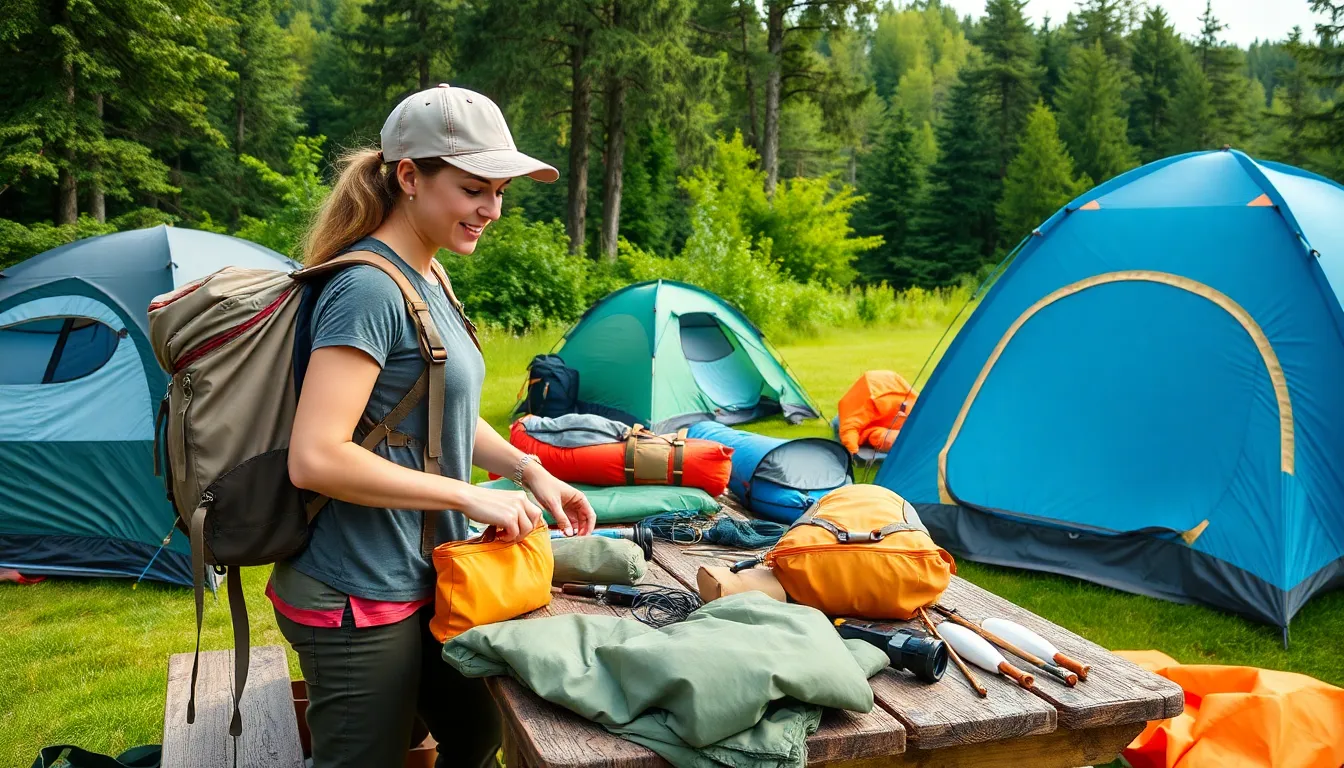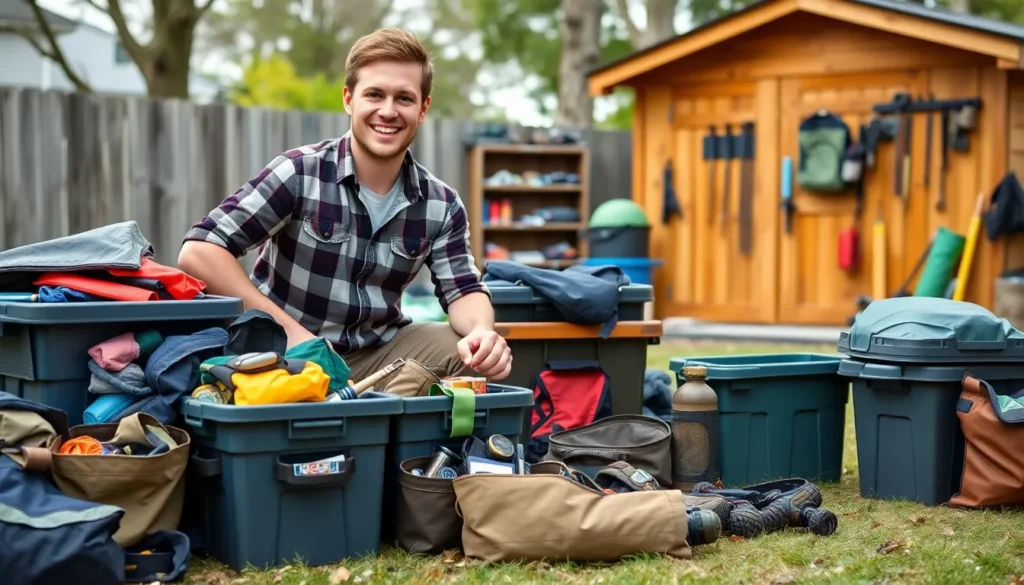Table of Contents
ToggleOutdoor adventures bring joy and excitement, but they can also lead to chaos if gear isn’t properly organized. From hiking boots to camping stoves, having a clutter-free space makes it easier to prepare for the next big trip. When outdoor gear is well-organized, it not only saves time but also enhances the overall experience.
Effective organization techniques can transform any storage area into a functional and efficient system. By categorizing items and utilizing smart storage solutions, outdoor enthusiasts can ensure that everything is easily accessible and ready for action. Whether it’s a weekend getaway or an extended expedition, a little planning goes a long way in maximizing enjoyment and minimizing stress.
Importance of Organizing Outdoor Gear
Organizing outdoor gear enhances trip preparation and enjoyment. A structured approach simplifies access to essential items, reducing the time spent searching for gear. By categorizing equipment, individuals can quickly locate what they need, whether it’s hiking boots or camping stoves.
Organization minimizes stress. When gear is stored methodically, enthusiasts face fewer last-minute surprises, such as missing items. Knowing where everything is allows for a smoother transition from home to nature.
Proper storage solutions foster safety. Equipment that isn’t organized can lead to accidents, such as tripping over misplaced items. A tidy space helps prevent injuries and ensures the safety of everyone involved in outdoor activities.
Effective gear organization also prolongs the lifespan of items. Regular maintenance and proper storage prevent damage from wear or environmental exposure. This proactive approach saves money by reducing the need for replacements.
Ultimately, an organized gear system contributes to a more fulfilling outdoor experience. It enables enthusiasts to focus on exploration and connection with nature, rather than on logistical challenges.
Types of Outdoor Gear

Various types of outdoor gear exist, each tailored for specific activities. Understanding these categories ensures effective organization, making outdoor adventures more enjoyable.
Camping Equipment
Camping equipment includes items essential for overnight stays in nature. Key components consist of:
- Tents: Varieties include dome, backpacking, and family tents, each suited to different group sizes and conditions.
- Sleeping bags: Options range from lightweight summer bags to insulated winter sleeping bags, catering to varying climates.
- Camping stoves: Choices include portable single-burner stoves and multi-burner setups, facilitating meal preparation.
- Coolers: Styles vary from soft-sided coolers to hard-shell models, equipped to keep perishables fresh.
- Lighting: Solutions encompass lanterns, headlamps, and flashlights, enhancing visibility during nighttime activities.
Hiking Gear
Hiking gear comprises items needed for safe and enjoyable trail experiences. Essential items include:
- Backpacks: Options span from daypacks for short hikes to larger backpacks for multi-day excursions, ensuring proper load distribution.
- Footwear: Types include trail running shoes, hiking boots, and sandals, each offering specific support and traction.
- Clothing: Layering systems consist of moisture-wicking base layers, insulating mid-layers, and waterproof outer layers tailored to weather conditions.
- Navigation tools: Items like maps, compasses, and GPS devices provide essential support for route finding.
- Trekking poles: Adjustable and lightweight trekking poles enhance stability and reduce strain on joints during treks.
Fishing Supplies
- Rod and reel combos: Various options target specific types of fishing, such as spinning, baitcasting, or fly fishing.
- Tackle boxes: Styles vary from small portable boxes to large gear organizers, ensuring ease of access to baits and lures.
- Baits and lures: Choices include live baits, soft plastics, and artificial lures, catering to different fish species and environments.
- Fishing line: Types include monofilament, fluorocarbon, and braided lines, each suited for varying conditions and fish sizes.
- Safety equipment: Essentials such as life jackets and first-aid kits provide necessary precautions during fishing outings.
Tips for Organizing Outdoor Gear
Organizing outdoor gear requires effective storage and clear labeling to ensure easy access during adventures. Implementing these strategies enhances the efficiency of preparation and enjoyment of outdoor activities.
Storage Solutions
Using appropriate storage solutions maximizes space and accessibility.
- Containers: Utilize sturdy bins or boxes for sorting gear by category. Waterproof containers protect against moisture and pests.
- Shelving Units: Install shelves in garages or sheds for bulky items. Use adjustable shelves to accommodate various sizes of gear.
- Hanging Racks: Hang bikes, kayaks, and other equipment on wall-mounted racks. This approach saves floor space and keeps gear off the ground.
- Under-Bed Storage: Use under-bed bins for seasonal gear. These bins can store items like sleeping bags, extra clothing, or camping tools.
- Portable Organizers: Choose backpacks or tackle boxes with individual compartments. These allow for easy transportation and quick access to smaller items.
Labeling Strategies
Implementing labeling strategies streamlines gear management and retrieval.
- Label Maker: Use a label maker for clear, professional-looking labels. Durable labels withstand outdoor conditions and remain legible over time.
- Color Coding: Assign different colors to labels for specific categories. For example, blue for fishing gear, green for hiking equipment, and red for camping supplies.
- Inventory Lists: Create an inventory list for each storage container or area. Keep a master list to track the contents of each categorized section.
- QR Codes: Utilize QR codes linked to digital lists or photos of gear. Scanning the codes quickly identifies contents without opening containers.
- Visibility: Place labels at eye level on containers or shelves. Ensure labels are easily visible when accessing stored items.
Employing these organization tips allows outdoor enthusiasts to efficiently manage their gear, contributing to a more enjoyable experience while exploring nature.
Maintaining an Organized Outdoor Space
Maintaining an organized outdoor space enhances functionality and enjoyment for outdoor enthusiasts. Prioritizing designated areas for each gear category fosters easy access and efficient use.
Regular Organization Checks
Perform regular organization checks to prevent clutter. Schedule these checks monthly, ensuring all items are in their designated spaces. During these reviews, discard or donate gear that’s no longer needed, keeping the area streamlined.
Seasonal Gear Rotation
Implement seasonal gear rotation to adapt to changing needs. Store off-season gear in less accessible areas, freeing up valuable space for frequently used items. For example, keep camping gear accessible in spring and summer while relocating skiing equipment in fall and winter.
Efficient Storage Solutions
Utilize efficient storage solutions for optimal space management. Mobile storage carts and collapsible bins facilitate movement for cleaning or alterations. Wall-mounted racks hold items such as bikes or fishing rods, providing easy visibility and accessibility.
Protective Measures
Adopt protective measures to safeguard gear from environmental elements. Store camping tents in breathable storage bags to prevent mildew, while fishing rods benefit from vertical racks. Additionally, using waterproof containers for electronics or clothing avoids damage during unpredictable weather.
Clear Labeling Systems
Implement clear labeling systems to simplify identification. Affix labels on storage bins detailing their contents, improving organization and reducing search times. Color-coded labels indicate seasonal use or activity types, offering visual cues that enhance efficiency.
Keep Essential Items Accessible
Keep essential items, such as first-aid kits or flashlights, in easily reachable locations. Storing them in a dedicated drawer or carrying bag prevents delays during outdoor activities. This accessibility promotes safety and preparedness on excursions.
Utilize Vertical Space
Maximize vertical space for a comprehensive organizational strategy. Install shelving units or pegboards to store smaller gear. Hanging items such as ropes or climbing gear on walls optimizes floor space and helps maintain a clutter-free environment.
Create a Maintenance Schedule
Establish a maintenance schedule that includes cleaning and organizing tasks biannually. Regular cleaning improves durability of gear, while maintaining organization reduces stress during prep times.
By implementing these strategies, outdoor enthusiasts can maintain an organized outdoor space that enhances their experiences in nature, promotes safety, and encourages efficiency during adventures.
Organizing outdoor gear is essential for enhancing the overall adventure experience. By creating a systematic approach to gear management, outdoor enthusiasts can enjoy smoother preparations and minimize stress.
Implementing effective storage solutions and clear labeling not only makes gear easily accessible but also promotes safety during outings. Regular maintenance and seasonal rotations ensure that gear remains in top condition and ready for use.
Ultimately, a well-organized outdoor space allows individuals to focus on what truly matters—exploring the great outdoors and connecting with nature. With these strategies in place, every adventure can be enjoyable and memorable.





